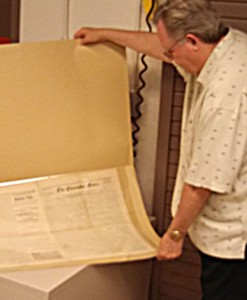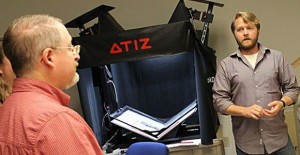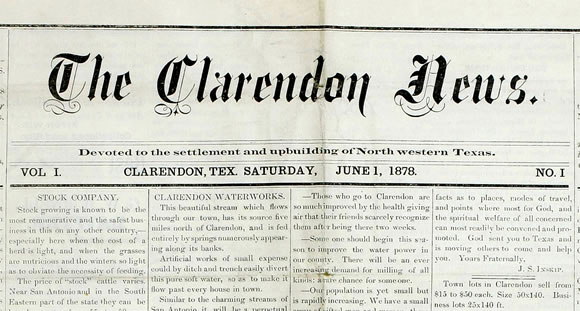Newspapers are the first drafts of history, and for some rural communities, what went down in the local paper may be the only record of days long gone.
But the importance of the medium is often betrayed by the medium itself as the poor quality of newsprint causes it to deteriorate over time until it literally turns to dust. When that happens, that recorded history is gone forever; but archivists at Texas Tech University are working diligently so that the history of West Texas is not only preserved but made available to people around the world on the Internet.
Clarendon’s newspaper is one of the central publications in a digitization effort at Tech’s Southwest Collection, a branch of the TTU library that was founded in the 1920s to preserve the history of West Texas ranches.

There were no newspapers in the “Texas Pan Handle” when Rev. L.H. Carhart brought his Christian colonists to the banks of the Salt Fork of the Red River 135 years ago. Under his direction, The Clarendon News made its “editorial nod” on June 1, 1878, making history and beginning the task of recording the happenings of what would become Donley County.
Though the paper went through several owners and name changes, it maintained its role as community historian and occasionally referenced its earliest issues. But sometime before 1945, many of the paper’s original files disappeared. Local searches for the first of edition of the News proved futile, until it was discovered in stash of 88 early Clarendon papers by a rare book dealer in Pennsylvania in 2006.
The Clarendon Enterprise moved quickly to secure the papers, and publisher Roger Estlack contacted archivists at the Southwest Collection to care for the rare issues. There they waited in climate-controlled, secure storage until technology, resources, and know-how were ready to digitize the collection and make it available for the future.
“Seven years ago, we didn’t even know these things existed anymore,” Estlack said. “Today, they have been scanned and are searchable by anyone, anywhere, anytime. We have not only rediscovered our community’s earliest history, we have preserved it.”
Southwest Collection Archivist Monte Monroe says a team of about 20 people at Tech are working to digitize regional newspapers and other holdings of the collection.

Tech’s interest in the area newspapers dates back to the 1970s when the Texas Newspaper Project saw a lot of old papers put on microfilm at several institutions around the state. The archives of The Donley County Leader were filmed by the Panhandle-Plains Historical Museum in Canyon at that time, and the Hedley Informer were later filmed at Tech.
Monroe says microfilm is the best long-term archive solution, and papers that are digitized can be migrated to film for a price.
“Microfilm will last at least 100 years,” Monroe said. “Digitization may last only 10 or 15 years as technology changes, but the files can be migrated to new technology.”
Archivist Robert Weaver says he’s able to scan about 40 papers per day with a $20,000 setup that utilizes two Canon EOS 5D digital cameras to take high resolutions photos of each page. Software is then used to convert those files to documents that can actually be read by computers using optical character recognition, enabling readers to search for a word like “Goodnight” in old Clarendon papers.
But the time consuming part of the process is adding what’s known as metadata to each file. Student workers assist Southwest Collection archivists in attaching keywords to each file so that search engines, such as Google, can find the files in the collection. Historic copies of the News, for example would be associated with keywords such as “Clarendon,” “Texas,” “Carhart,” and other pertinent words that might lead a researcher to that issue.
With literally millions of items in the collection, digitization is an ongoing and expensive project, but getting these historic documents – whether they be local newspapers or the handwritten letters of Civil War soldiers – online and available to researchers is a motivating factor.
Documents digitized by the Southwest Collection are not only backed up at Texas Tech but also with the Texas Digital Library, a joint partnership of Tier One universities across the state, Monroe said.
With the earliest Clarendon papers digitized, plans are now in the works to digitize more local papers, using material that was microfilmed by the Panhandle-Plains Historical Museum, The Clarendon Press under publisher Helen Woody, and the Clarendon High School Library under former librarians Jean Stavenhagen and Sharon Elam.
More recent issues of The Clarendon Enterprise that were “born” digital will also eventually be added to the collection as archivists and local historians work to preserve the history of Donley County.
To read the first issue of The Clarendon News, visit our website www.ClarendonLive.com or go directly to http://bit.ly/1hAiQUg.



Leave a Reply
You must be logged in to post a comment.